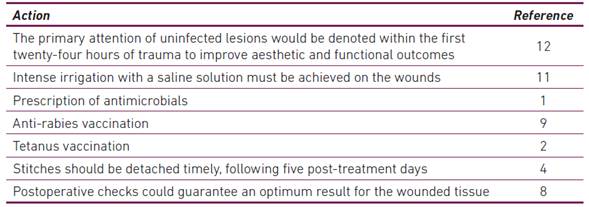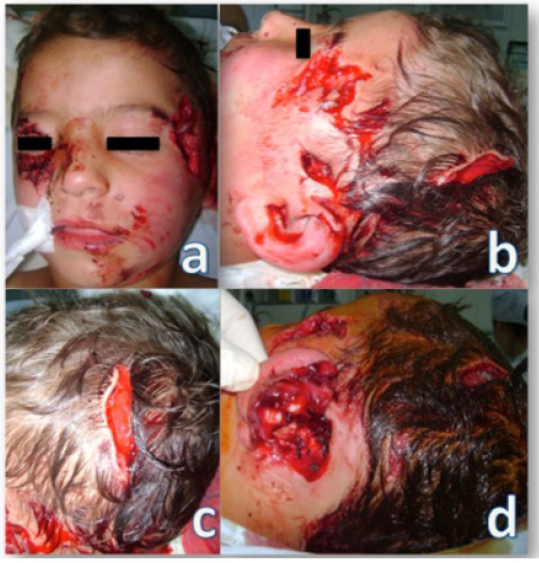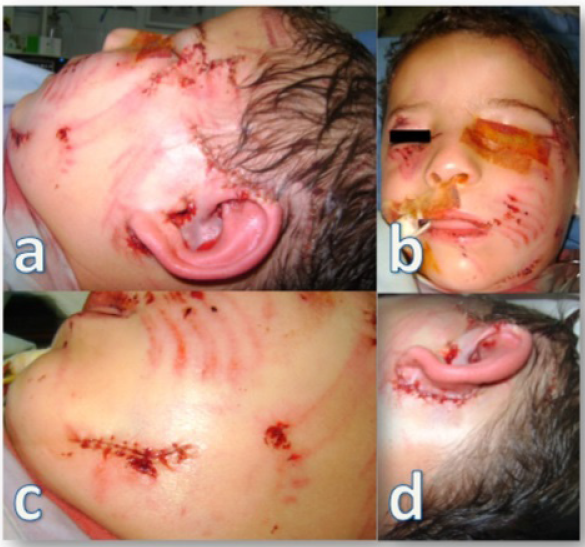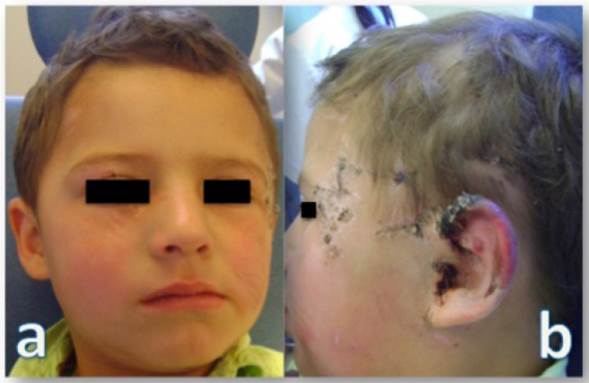Reporte de caso
Maxillofacial management of dog bites injuries in an infant: A case report
Manejo maxillofacial por mordeduras de perro en un infante: Reporte de un caso
Manejo maxilofacial de mordidas de cães em criança: Relato de caso
Carlos-Martín Ardila1
Natalia Contreras-Gómez2
Efraín Álvarez-Martínez3
1. Periodontist, Ph.D. in Epidemiology, Biomedical Stomatology Research Group. Titular Professor Universidad de Antioquia., Medellín, Colombia. ORCID 0000-0002-3663-1416. E-mail: martin.ardila@udea.edu.co
2. Oral and Maxillofacial Surgeon. Universidad de Antioquia. Medellín, Colombia. ORCID 0000-0001-5440-6274. E-mail: natacogo85@gmail.com
3. Oral and Maxillofacial Surgeon. Titular Professor Universidad de Antioquia., Medellín, Colombia. ORCID 0000-0003-0328-4902. E-mail:efrain.alvarez@udea.edu.co
Abstract
Dog bites cause complex craniomaxillofacial injuries. Considering that the bite injuries are repeatedly situated on the face, dentist requires being well known with the therapy of animal bites. A three-year-old male child was attended as a victim of a Pit Bull terrier biting. The patient had multiple wounds at the level of the upper eyelid of the right eyeball, left hemisphere with the involvement of the auricular pavilion, wounds with multiple detachments on face and scalp, several abrasions and ecchymoses in the bilateral infraorbital and mouth region. The clinical intervention was completed in the first twenty-four hours after injury. The affected zones were cleaned and irrigated with saline solution, and the wounds were sutured in layers. Tetanus and anti-rabies vaccination, and antibiotic and analgesic were administered. On the fifth postoperative day, the stitches were removed, and the patient was discharged from the hospital. One week after the trauma, the child showed adequate wound curing absent of aggravation. Satisfactory aesthetic and functional results were achieved. Besides, in this case, the most relevant aspects of the management of dogs bites are presented.
Keywords: bites and stings; dogs; wounds and injuries; maxillofacial injuries; head injuries
Resumen
Las mordeduras de perros causan lesiones craneomaxilofaciales complejas. Teniendo en cuenta que las lesiones por mordedura están situadas repetidamente en la cara, el odontólogo debe conocer la terapia que se debe realizar en el caso de mordeduras de animales. Un niño de tres años fue atendido como víctima de una mordedura de Pit Bull terrier. El paciente tenía múltiples heridas a nivel del párpado superior del globo ocular derecho, hemisferio izquierdo con afectación del pabellón auricular, heridas con múltiples desprendimientos en la cara y el cuero cabelludo, varias abrasiones y equimosis en la región bilateral infraorbitaria y bucal. La intervención clínica se completó en las primeras veinticuatro horas después de la lesión. Las zonas afectadas se limpiaron e irrigaron con solución salina, y las heridas se suturaron en capas. Se administraron vacuna antitetánica y antirrábica, antibióticos y analgésicos. En el quinto día postoperatorio, se retiraron los puntos de sutura y el paciente fue dado de alta del hospital. Una semana después del trauma, el niño mostró curación adecuada de la herida sin agravación. Se lograron resultados estéticos y funcionales satisfactorios. Además, en este caso, se presentan los aspectos más relevantes del manejo de las mordeduras de perros.
Palabras clave: mordeduras y picaduras; perros; heridas y daños; lesiones maxilofaciales; heridas en la cabeza
Resumo
Mordidas de cães causam lesões craniomaxilofaciais complexas. Considerando que as lesões por mordidas são repetidamente situadas na face, um cirurgião oral e maxilofacial exige ser bem conhecido com a terapia de mordidas de animais. Um menino de três anos foi vítima de uma picada de um terrier de Pit Bull. O paciente apresentava múltiplas feridas no nível da pálpebra superior do globo ocular direito, hemisfério esquerdo com envolvimento do pavilhão auricular, feridas com múltiplos descolamentos na face e couro cabeludo, várias abrasões e equimoses na região infraorbital e boca bilateral. A intervenção clínica foi concluída nas primeiras vinte e quatro horas após a lesão. As zonas afetadas foram limpas e irrigadas com solução salina e as feridas foram suturadas em camadas. Vacinação antitetânica e anti-rábica e antibióticos e analgésicos foram administrados. No quinto dia de pós-operatório, os pontos foram retirados e a paciente recebeu alta do hospital. Uma semana após o trauma, a criança apresentou cura adequada da ferida, sem agravamento. Resultados estéticos e funcionais satisfatórios foram alcançados. Além disso, neste caso, são apresentados os aspectos mais relevantes no manejo das mordidas de cães.
Palavras-chave: mordidas e picadas; cães; feridas e lesões; lesões maxilofaciais; ferimentos na cabeça
Introduction
Dog bites occasion complicated craniomaxillofacial damages. Functional, cosmetic impairment and probable septicity are demanding for maxillofacial specialists (1). Children under ten years are the most usual victims of dog bites (2), in whom, the most regular damaged parts are the head, face, and neck (3), where the principal affected zones are the nose and the auricles (2). The tissue damage may be on the surface, but they could provoke amputations (2). The handling for children affected by trauma produced by bites of dogs merits singular care. Besides, aesthetic implications are relevant (1). Considering that the bite injuries are repeatedly situated on the face, an oral and maxillofacial surgeon requires being well known with the therapy of animal bites (4).
This case presents the maxillofacial management of multiple lacerations on mouth, face, and head caused by dog bites in an infant; besides, most pertinent aspects for the management of dogs bites are commented.
Case report
A three-year male infant was received at the service of Stomatology and Maxillofacial Surgery at the San Vicente Hospital in Medellin, Colombia, as a victim of a Pit Bull terrier biting. Before any intervention, written permission of the parents rendering to ethical criterion was signed; also, the Helsinki Declaration guidelines were followed in this case. The patient had multiple wounds at the level of the upper eyelid of the right eyeball, left hemisphere with the involvement of the auricular pavilion, wounds with multiple detachments on face and scalp, several abrasions and ecchymosis in the bilateral infraorbital and mouth region (Figure 1).
The clinical intervention was completed under general anesthesia in the first 24 hours after injury. The affected zones were cleaned and irrigated with saline solution, and iodopovidone. The wounds were sutured in layers, including muscles, using vicryl (4-0) and monocryl (5-0) (Figure 2).
Tetanus and anti-rabies vaccination, and antibiotic (ampicillin with sulbactam) and analgesic (tramadol) were administered. On the fifth postoperative day, the stitches (except the left auricular pavilion) were removed, and the infant was discharged from the hospital. His parents were guided on the administration of the medicine (antibiotic and analgesic) and attention on sanitization and antisepsis of the lesions. One week after the trauma, the child showed adequate wound curing absent of aggravation (Figure 3).
Table 1 Most relevant aspects for the management of canine bites.

Table 1 highlights the most relevant aspects for the management of canine bites
Discussion
As was described in this case, children are the most injured by dog’s attacks, affecting principally kids less than five years old [4]. Besides, this report confirms previous works that informed that Pit Bull Terrier is the significant species implicated in this kind of injuries; this dog is characterized by ferociousness and corporeal imposture (5).
As occurred in the present case, lesions caused by canine’s bite involve superficial tissues, including or no loss of substance, to facial and cranial harm (6); besides, the lacerations are seldom related to facial bone fractures (7). Nevertheless, sometimes the wounds can conduct to amputations, counting serious vascular and nerve or bony affection (8). In the present case, the left auricular pavilion had a grave detachment (Figure 1d).
Reasons as the number of wounds made and their position, impact the therapeutic conduct to be assumed (9). As was implemented in this case, the initial management of bites was direct suture; however, grafting or flaps could be needed depending on the seriousness of the damage (10). Besides, the recommendation about irrigation with a saline solution was applied; this advice reduces microbial load and to subtract undesirable elements and remains (11-13).
Considering that most infections related to dog bites are a combination of anaerobic and aerobic microorganisms, antimicrobials are recommended, suggesting penicillin the first select; however, amoxicillin and clavulanic acid (gold standard) are the most regularly suggested, succeeded by IV generation cephalosporin and ampicillin with sulbactam (1,12,14). In cases of hypersensitivity, alternative antimicrobials must be advocated.
The management of anti-rabies vaccination continues the gold standard of therapy for animal bite lesions (9,15). Besides, a tetanus vaccination must be considered in the case the child has not been immunized in the preceding five years (2).
Finally, postoperative checks could guarantee an optimum result for the wounded tissue (8). Besides, inter-consultation with other medical specialties as plastic surgery, ophthalmology, orthopedics, neurosurgery, and psychology, among others, it is recommended for severe harms, particularly those concerning disfigurement (4,15).
Conclusions
It is relevant to highlight that in this case, the principal recommendations to the management of dog bites were applied, as they are described in Table 1, which allowed obtaining satisfactory results. Moreover, public health policies must be enforced to prevent dog bites.
Funding
There was no finance for this case report.
Disclosure of interest
There is no competing interest related to this case report
References
1. Heitz C, Louzada GP, Conci RA, Rodrigues RL, Fritscher GG. Primary Repair of a Complex Panfacial Fracture by Dog Bite. Plast Reconstr Surg Glob Open. 2018;6(4):e1719.
[ Links ]
2. Abuabara A. A review of facial injuries due to dog bites. Med Oral Patol Oral Cir Bucal. 2006;11(4):E348-350.
[ Links ]
3. Lin W, Patil PM. Facial dog attack injuries. Indian J Surg. 2015;77(1):55-58.
[ Links ]
4. Chhabra S, Chhabra N, Gaba S. Maxillofacial injuries due to animal bites. J Maxillofac Oral Surg. 2015;14(2):142-153.
[ Links ]
5. Foster MD, Hudson JW. Contemporary update on the treatment of dog bite: injuries to the oral and maxillofacial region. J Oral Maxillofac Surg. 2015;73(5):935-942.
[ Links ]
6. Bykowski MR, Shakir S, Naran S, Smith DM, Goldstein JA, Grunwaldt L, et al. Pediatric Dog Bite Prevention: Are We Barking Up the Wrong Tree or Just Not Barking Loud Enough? Pediatr Emerg Care. 2019;35(9):618-623.
[ Links ]
7. Tu AH, Girotto JA, Singh N, Dufresne CR, Robertson BC, Seyfer AE, et al. Facial fractures from dog bite injuries. Plast Reconstr Surg. 2002;109(4):1259-1265.
[ Links ]
8. Agrawal A, Kumar P, Singhal R, Singh V, Bhagol A. Animal Bite Injuries in Children: Review of Literature and Case Series. Int J Clin Pediatr Dent. 2017;10(1):67-72.
[ Links ]
9. Cavalcanti AL, Porto E, Dos Santos BF, Cavalcanti CL, Cavalcanti AFC. Facial dog bite injuries in children: A case report. Int J Surg Case Rep. 2017;41:57-60.
[ Links ]
10. Macedo JL, Rosa SC, Queiroz MN, Gomes TG. Reconstruction of face and scalp after dog bites in children. Rev Col Bras Cir. 2016;43(6):452-457.
[ Links ]
11. Stefanopoulos PK, Tarantzopoulou AD. Facial bite wounds: management update. Int J Oral Maxillofac Surg. 2005;34(5): 464-472.
[ Links ]
12. Mcheik JN, Vergnes P, Bondonny JM. Treatment of facial dog bite injuries in children: a retrospective study. J Pediatr Surg. 2000;35(4):580-583.
[ Links ]
13. Gurunluoglu R, Glasgow M, Arton J, Bronsert M. Retrospective analysis of facial dog bite injuries at a Level I trauma center in the Denver metro area. J Trauma Acute Care Surg. 2014;76(5):1294-1300.
[ Links ]
14. Baldi JR, Wolff de Freitas DA. Mandible and Zygomatic Fracture in a 2-Year-Old Patient due to Dog Bite. Craniomaxillofac Trauma Reconstr. 2013;6(2):137-142.
[ Links ]
15. Kumar R, Deleyiannis FW, Wilkinson C, O'Neill BR. Neurosurgical sequelae of domestic dog attacks in children. J Neurosurg Pediatr. 2017;19(1):24-31.
[ Links ]


















